译林小学英语语法汇总教学
- 格式:pdf
- 大小:684.44 KB
- 文档页数:51
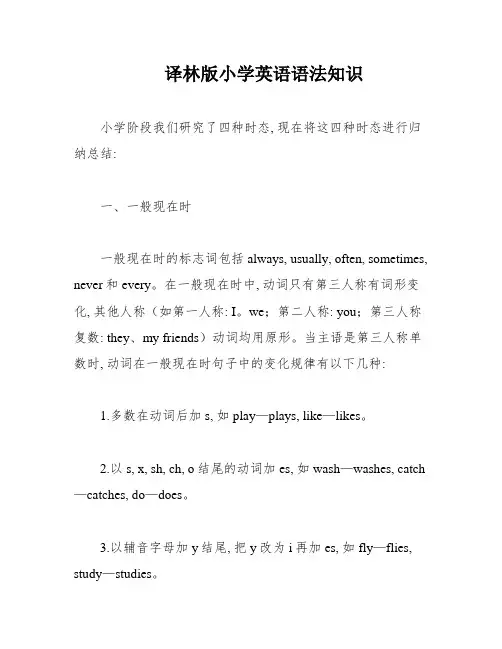
译林版小学英语语法知识小学阶段我们研究了四种时态, 现在将这四种时态进行归纳总结:一、一般现在时一般现在时的标志词包括always, usually, often, sometimes, never和every。
在一般现在时中, 动词只有第三人称有词形变化, 其他人称(如第一人称: I。
we;第二人称: you;第三人称复数: they、my friends)动词均用原形。
当主语是第三人称单数时, 动词在一般现在时句子中的变化规律有以下几种:1.多数在动词后加s, 如play—plays, like—likes。
2.以s, x, sh, ch, o结尾的动词加es, 如wash—washes, catch —catches, do—does。
3.以辅音字母加y结尾, 把y改为i再加es, 如fly—flies, study—studies。
4.以元音字母加y结尾, 直接加s, 如buy—buys。
5.不规则变化, 如have—has。
一般现在时的基本用法有以下几种:1.表示事物或人物的特征、状态, 如The sky is blue.(天空是蓝色的)。
2.表示经常性或惯性的动作, 如I get up at six every day.(我每天六点起床)。
3.表示客观现实, 如XXX around the sun.(地球绕着太阳转)。
一般现在时的构成有以下两种:1.be动词: 主语+be(am。
is。
are)+其它, 如I am a boy.(我是一个男孩)。
2.行为动词: 主语+行为动词(+其它), 如XXX.(我们研究英语)。
一般现在时的句型包括肯定句、否定句和一般疑问句:1.肯定句:A。
be动词: 主语+be+其它成分, 如He is a worker.(他是一名工人)。
B。
行为动词: 主语+动词(注意人称变化)+其它成分, 如We like the little cat.(我们喜欢这只小猫)。
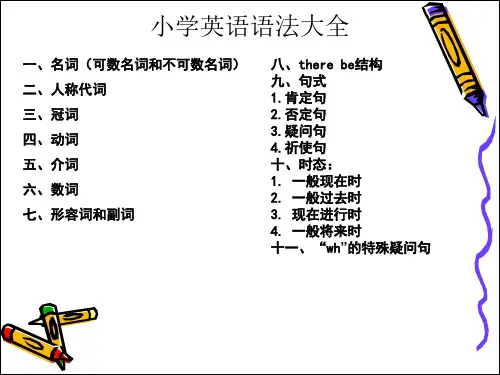
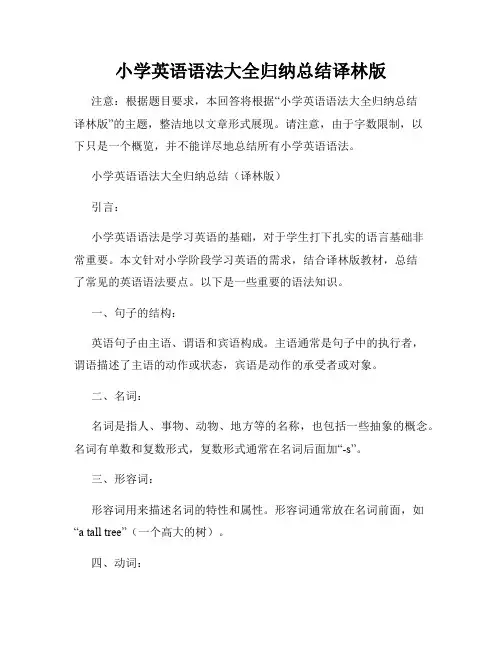
小学英语语法大全归纳总结译林版注意:根据题目要求,本回答将根据“小学英语语法大全归纳总结译林版”的主题,整洁地以文章形式展现。
请注意,由于字数限制,以下只是一个概览,并不能详尽地总结所有小学英语语法。
小学英语语法大全归纳总结(译林版)引言:小学英语语法是学习英语的基础,对于学生打下扎实的语言基础非常重要。
本文针对小学阶段学习英语的需求,结合译林版教材,总结了常见的英语语法要点。
以下是一些重要的语法知识。
一、句子的结构:英语句子由主语、谓语和宾语构成。
主语通常是句子中的执行者,谓语描述了主语的动作或状态,宾语是动作的承受者或对象。
二、名词:名词是指人、事物、动物、地方等的名称,也包括一些抽象的概念。
名词有单数和复数形式,复数形式通常在名词后面加“-s”。
三、形容词:形容词用来描述名词的特性和属性。
形容词通常放在名词前面,如“a tall tree”(一个高大的树)。
四、动词:动词表示行动、状态和发生的事件。
动词有不同的时态形式,例如现在时、过去时和将来时。
动词的时态可以通过动词的变化,如加“-ed”或“-ing”,来表示。
五、副词:副词用来描述动词、形容词和其他副词。
副词通常放在动词前面,如“I run quickly”(我跑得快)。
六、代词:代词用于代替名词,以避免重复。
常见的代词包括“he”(他),“she”(她),“it”(它)等。
七、介词:介词用于连接名词和其他词。
常见的介词包括“in”(在),“on”(在……上),“at”(在……处)等。
八、冠词:冠词用于修饰名词,表示特指或泛指。
常见的冠词有“a”(一个),“an”(一个,用于元音开头的词前)和“the”(这,那)。
九、连词:连词用于连接词语、短语和句子。
常见的连词包括“and”(和),“but”(但是),“or”(或者)等。
十、语序:英语中的语序通常为主语-谓语-宾语的顺序。
但是,疑问句的语序为谓语-主语-宾语。
结论:通过本文对小学英语语法的概要介绍,我们可以看到语法是学习英语的重要基础。
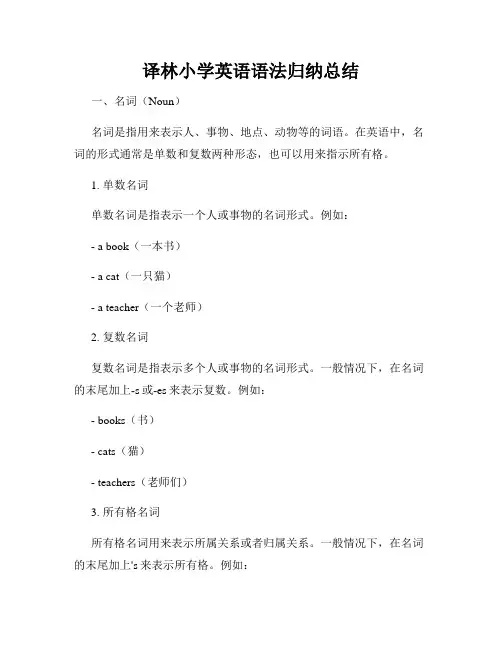
译林小学英语语法归纳总结一、名词(Noun)名词是指用来表示人、事物、地点、动物等的词语。
在英语中,名词的形式通常是单数和复数两种形态,也可以用来指示所有格。
1. 单数名词单数名词是指表示一个人或事物的名词形式。
例如:- a book(一本书)- a cat(一只猫)- a teacher(一个老师)2. 复数名词复数名词是指表示多个人或事物的名词形式。
一般情况下,在名词的末尾加上-s或-es来表示复数。
例如:- books(书)- cats(猫)- teachers(老师们)3. 所有格名词所有格名词用来表示所属关系或者归属关系。
一般情况下,在名词的末尾加上's来表示所有格。
例如:- John's book(约翰的书)- the cat's tail(猫的尾巴)- the teacher's desk(老师的桌子)二、冠词(Article)冠词是指用来限定名词用法的小词。
在英语中,有不定冠词a/an和定冠词the两种。
1. 不定冠词(a/an)不定冠词用来表示泛指的概念,意为“一”或“一个”。
例如:- a book(一本书)- an apple(一个苹果)2. 定冠词(the)定冠词用来表示特指的概念,意为“那个”或“这个”。
例如:- the book(那本书)- the apple(那个苹果)三、形容词(Adjective)形容词是指用来描述名词特征或者性质的词语。
在英语中,形容词通常用来修饰名词,增强词语的表达力。
例如:- a beautiful flower(一朵美丽的花)- an interesting book(一本有趣的书)形容词在句子中可以用来比较和最高级的表达。
比较级用于两个事物之间的比较,最高级则是三个或三个以上事物之间的比较。
例如:- Emma is taller than Sarah.(埃玛比萨拉更高。
)- This is the most delicious cake I have ever tasted.(这是我尝过的最美味的蛋糕。
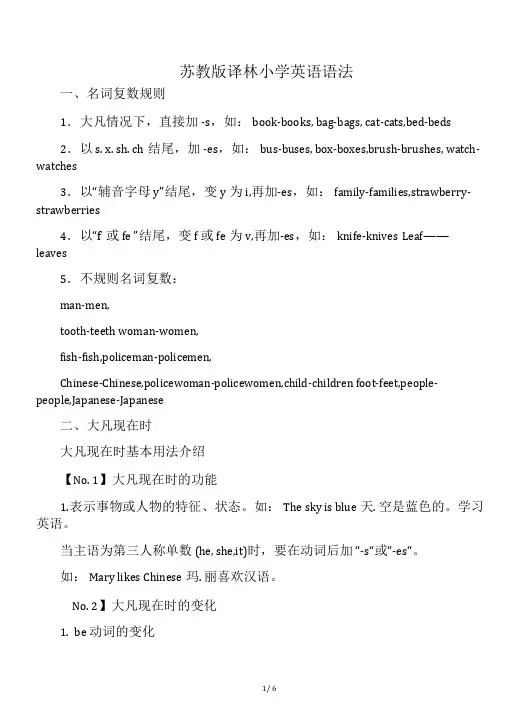
苏教版译林小学英语语法一、名词复数规则1.大凡情况下,直接加-s,如:book-books, bag-bags, cat-cats,bed-beds2.以s. x. sh. ch结尾,加-es,如:bus-buses, box-boxes,brush-brushes, watch-watches3.以“辅音字母y”结尾,变y为i,再加-es,如:family-families,strawberry- strawberries4.以“f或fe ”结尾,变f 或fe为v,再加-es,如:knife-knives Leaf——leaves5.不规则名词复数:man-men,tooth-teeth woman-women,fish-fish,policeman-policemen,Chinese-Chinese,policewoman-policewomen,child-children foot-feet,people- people,Japanese-Japanese二、大凡现在时大凡现在时基本用法介绍【No. 1】大凡现在时的功能1.表示事物或人物的特征、状态。
如:The sky is blue天. 空是蓝色的。
学习英语。
当主语为第三人称单数(he, she,it)时,要在动词后加“-s“或“-es“。
如:Mary likes Chinese玛. 丽喜欢汉语。
No. 2】大凡现在时的变化1.be 动词的变化否定句:主语be not 其它。
如:He is not a worker.他不是工人。
大凡疑问句:Be 主语其它。
如:-Are you a student?-Yes. I am. / No, I “ m not.非凡疑问句:疑问词大凡疑问句。
如:Where is my bike?2.行为动词的变化。
否定句:主语don“t(doesn “动t 词)原形(其它)。
如:I don “t like bread. 当主语为第三人称单数时,要用doesn“t构成否定句。
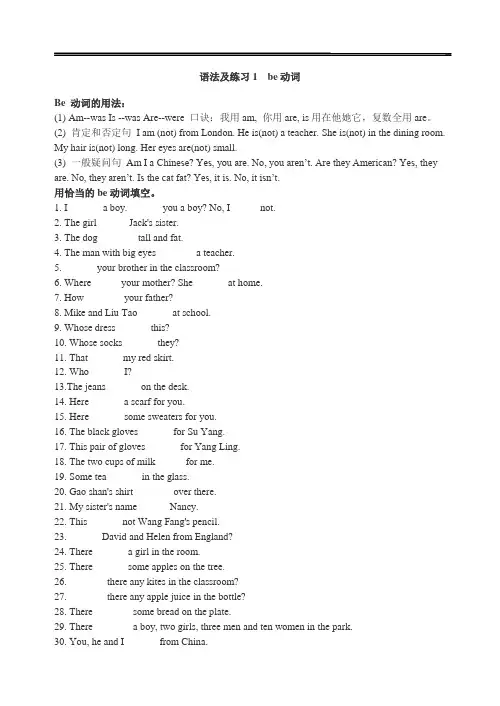
语法及练习1 be动词Be 动词的用法:(1) Am--was Is --was Are--were 口诀:我用am, 你用are, is用在他她它,复数全用are。
(2) 肯定和否定句I am (not) from London. He is(not) a teacher. She is(not) in the dining room. My hair is(not) long. Her eyes are(not) small.(3) 一般疑问句Am I a Chinese? Yes, you are. No, you aren’t. Are they American? Yes, they are. No, they aren’t. Is the cat fat? Yes, it is. No, it isn’t.用恰当的be动词填空。
1. I ______ a boy. ______ you a boy? No, I _____ not.2. The girl______ Jack's sister.3. The dog _______ tall and fat.4. The man with big eyes _______ a teacher.5. ______ your brother in the classroom?6. Where _____ your mother? She ______ at home.7. How _______ your father?8. Mike and Liu Tao ______ at school.9. Whose dress ______ this?10. Whose socks ______ they?11. That ______ my red skirt.12. Who ______ I?13.The jeans ______ on the desk.14. Here ______ a scarf for you.15. Here ______ some sweaters for you.16. The black gloves ______ for Su Yang.17. This pair of gloves ______ for Yang Ling.18. The two cups of milk _____ for me.19. Some tea ______ in the glass.20. Gao shan's shirt _______ over there.21. My sister's name ______Nancy.22. This ______ not Wang Fang's pencil.23. ______ David and Helen from England?24. There ______ a girl in the room.25. There ______ some apples on the tree.26. _______ there any kites in the classroom?27. _______ there any apple juice in the bottle?28. There _______ some bread on the plate.29. There _______ a boy, two girls, three men and ten women in the park.语法及练习2 人称代词和物主代词人称代词和物主代词1.人称代词主格和宾格的区别:主格通常位于句中第一个动词之前(有时候位于than 之后),宾格一般位于动词或介词之后。
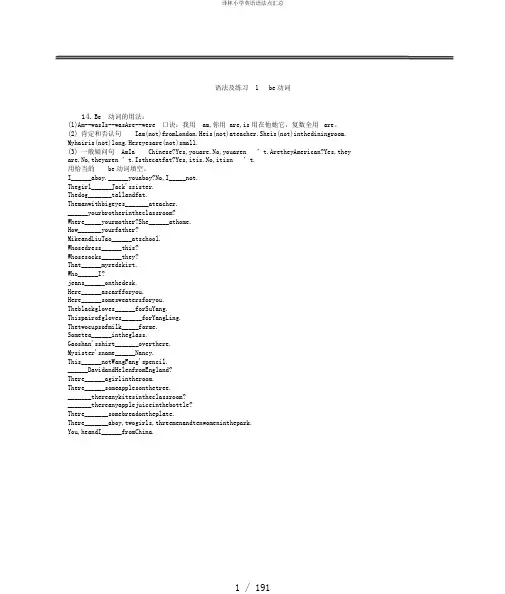
译林小学英语语法点汇总语法及练习 1 be动词14.B e 动词的用法:(1)Am--wasIs--wasAre--were 口诀:我用am,你用 are,is用在他她它,复数全用are。
(2) 肯定和否认句Iam(not)fromLondon.Heis(not)ateacher.Sheis(not)inthediningroom. Myhairis(not)long.Hereyesare(not)small.(3) 一般疑问句AmIa Chinese?Yes,youare.No,youaren ’t.AretheyAmerican?Yes,they are.No,theyaren ’t.Isthecatfat?Yes,itis.No,itisn’t.用恰当的be动词填空。
I______aboy.______youaboy?No,I_____not.Thegirl______Jack'ssister.Thedog_______tallandfat.Themanwithbigeyes_______ateacher.______yourbrotherintheclassroom?Where_____yourmother?She______athome.How_______yourfather?MikeandLiuTao______atschool.Whosedress______this?Whosesocks______they?That______myredskirt.Who______I?jeans______onthedesk.Here______ascarfforyou.Here______somesweatersforyou.Theblackgloves______forSuYang.Thispairofgloves______forYangLing.Thetwocupsofmilk_____forme.Sometea______intheglass.Gaoshan'sshirt_______overthere.Mysister'sname______Nancy.This______notWangFang'spencil.______DavidandHelenfromEngland?There______agirlintheroom.There______someapplesonthetree._______thereanykitesintheclassroom?_______thereanyapplejuiceinthebottle?There_______somebreadontheplate.There_______aboy,twogirls,threemenandtenwomeninthepark.You,heandI______fromChina.译林小学英语语法点汇总语法及练习2人称代词和物主代词人称代词和物主代词1.人称代词主格和宾格的区别:主格通常位于句中第一个动词之前〔有时候位于 than之后〕,宾格一般位于动词或介词之后。
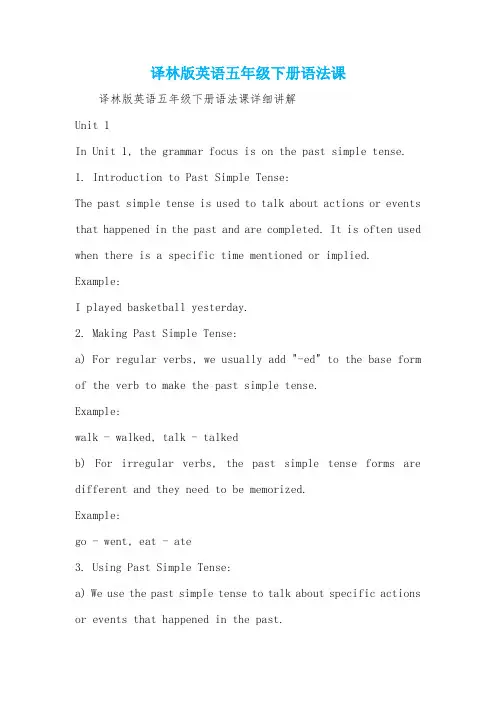
译林版英语五年级下册语法课译林版英语五年级下册语法课详细讲解Unit 1In Unit 1, the grammar focus is on the past simple tense. 1. Introduction to Past Simple Tense:The past simple tense is used to talk about actions or events that happened in the past and are completed. It is often used when there is a specific time mentioned or implied. Example:I played basketball yesterday.2. Making Past Simple Tense:a) For regular verbs, we usually add "-ed" to the base form of the verb to make the past simple tense.Example:walk - walked, talk - talkedb) For irregular verbs, the past simple tense forms are different and they need to be memorized.Example:go - went, eat - ate3. Using Past Simple Tense:a) We use the past simple tense to talk about specific actions or events that happened in the past.She visited her grandparents last weekend.b) We use the past simple tense to talk about a series of completed actions or events.Example:I woke up, brushed my teeth, and ate breakfast.c) We use the past simple tense to talk about a repeated action or event in the past.Example:I always ate breakfast before going to school.Unit 2In Unit 2, the grammar focus is on the present perfect tense.1. Introduction to Present Perfect Tense:The present perfect tense is used to talk about actions or events that happened in the past but have a connection to the present. It is often used when the exact time of the action is not mentioned or it is not important.Example:I have been to Paris.2. Making Present Perfect Tense:a) We form the present perfect tense by using "have" or "has" followed by the past participle form of the verb.I have eaten lunch.b) For regular verbs, we usually add "-ed" to the base form of the verb to make the past participle form.Example:walk - walked - have walked, talk - talked - have talkedc) For irregular verbs, the past participle forms are different and they need to be memorized.Example:go - went - have gone, eat - ate - have eaten3. Using Present Perfect Tense:a) We use the present perfect tense to talk about actions or events that happened at an unspecified time in the past and are related to the present.Example:She has written a book.b) We use the present perfect tense to talk about actions or events that started in the past and are still happening or have just finished.Example:I have lived in this city for five years.c) We use the present perfect tense to talk about pastexperiences.Example:Have you ever been to China?Unit 3In Unit 3, the grammar focus is on the future tense.1. Introduction to Future Tense:The future tense is used to talk about actions or events that will happen in the future.Example:I will go to the park tomorrow.2. Making Future Tense:a) We form the future tense by using "will" or "shall" followed by the base form of the verb.Example:I will play soccer.b) We can also use the present continuous tense to talk about future actions or events that are already planned or arranged. Example:I am going to visit my grandparents next week.3. Using Future Tense:a) We use the future tense to talk about actions or events that will happen in the future.Example:He will arrive at 8 pm.b) We can use the future tense to make predictions or talk about future possibilities.Example:It will rain tomorrow.c) We can also use the future tense to make requests or offers.Example:Will you help me with my homework?Unit 4In Unit 4, the grammar focus is on the comparative and superlative forms of adjectives.1. Comparative Forms of Adjectives:a) We form the comparative form of most adjectives by adding "-er" to the end of the adjective.Example:big - biggerb) For adjectives ending in "y", we change the "y" to "i" before adding "-er".Example:happy - happierc) For adjectives ending in consonant + vowel + consonant, we double the final consonant before adding "-er". Example:hot - hotter2. Superlative Forms of Adjectives:a) We form the superlative form of most adjectives by adding "-est" to the end of the adjective.Example:big - biggestb) For adjectives ending in "y", we change the "y" to "i" before adding "-est".Example:happy - happiestc) For adjectives ending in consonant + vowel + consonant, we double the final consonant before adding "-est". Example:hot - hottest3. Using Comparative and Superlative Forms of Adjectives:a) We use the comparative form of adjectives to compare two people or things.Example:She is taller than her sister.b) We use the superlative form of adjectives to compare more than two people or things.Example:He is the tallest student in the class.c) We can use "more" with longer adjectives or adjectives ending in "-ly" to form the comparative.Example:beautiful - more beautifuld) We can use "the most" with longer adjectives or adjectives ending in "-ly" to form the superlative.Example:beautiful - the most beautifulUnit 5In Unit 5, the grammar focus is on the use of "can" and "could" to express ability and permission.1. Using "can" to Express Ability:a) We use "can" to talk about general abilities or skills. Example:She can swim.b) We use "can" to talk about specific abilities or skills. Example:He can play the piano.2. Using "can" to Express Permission:a) We use "can" to ask for permission or to give permission in informal situations.Example:Can I go to the park?b) We use "can" to talk about general permission.Example:You can wear casual clothes.3. Using "could" to Express Ability and Permission:a) We use "could" to talk about past abilities or skills. Example:I could ride a bike when I was younger.b) We use "could" to ask for permission in a polite way. Example:Could I use your phone, please?c) We use "could" to talk about hypothetical or less certain abilities or permissions.Example:If I studied harder, I could pass the test.以上是对译林版英语五年级下册语法课的详细讲解。
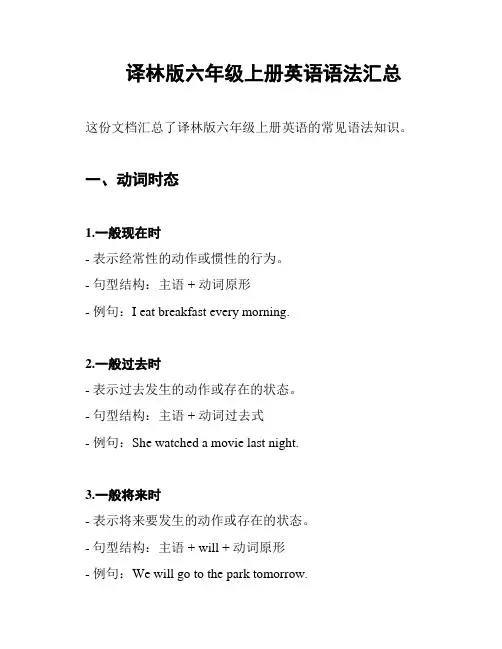
译林版六年级上册英语语法汇总这份文档汇总了译林版六年级上册英语的常见语法知识。
一、动词时态1.一般现在时- 表示经常性的动作或惯性的行为。
- 句型结构:主语 + 动词原形- 例句:I eat breakfast every morning.2.一般过去时- 表示过去发生的动作或存在的状态。
- 句型结构:主语 + 动词过去式- 例句:She watched a movie last night.3.一般将来时- 表示将来要发生的动作或存在的状态。
- 句型结构:主语 + will + 动词原形- 例句:We will go to the park tomorrow.二、名词的单复数1.可数名词的单复数- 可数名词表示可以计数的事物,有单数和复数形式。
- 例句:I have two dogs.2.不可数名词- 不可数名词表示不可计数的事物,只有单数形式。
- 例句:I have some milk.三、形容词的比较级与最高级1.比较级的形成- 在形容词后加-er,或在前面加more。
- 例句:She is taller than her sister. / He is more intelligent than his classmates.2.最高级的形成- 在形容词后加-est,或在前面加the most。
- 例句:He is the tallest boy in the class. / She is the most beautiful girl I have ever seen.四、副词的用法- 副词是用来修饰动词、形容词或其他副词的词语。
- 例句:He runs fast. / She sings beautifully.以上是译林版六年级上册英语的语法汇总,希望对你的学习有所帮助!。
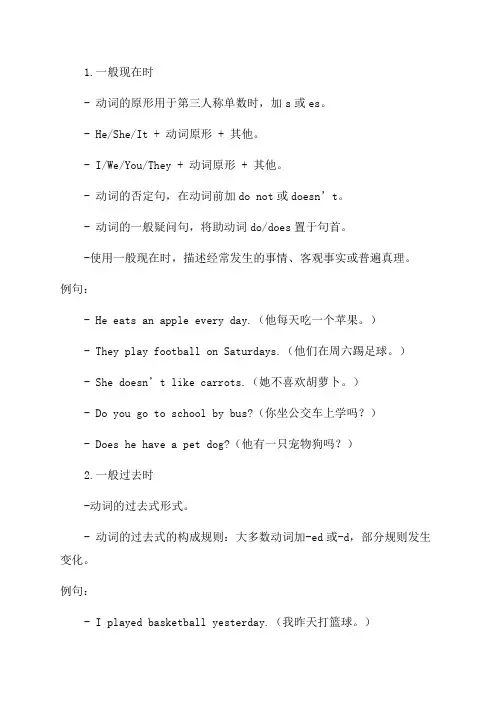
1.一般现在时- 动词的原形用于第三人称单数时,加s或es。
- He/She/It + 动词原形 + 其他。
- I/We/You/They + 动词原形 + 其他。
- 动词的否定句,在动词前加do not或doesn’t。
- 动词的一般疑问句,将助动词do/does置于句首。
-使用一般现在时,描述经常发生的事情、客观事实或普遍真理。
例句:- He eats an apple every day.(他每天吃一个苹果。
)- They play football on Saturdays.(他们在周六踢足球。
)- She doesn’t like carrots.(她不喜欢胡萝卜。
)- Do you go to school by bus?(你坐公交车上学吗?)- Does he have a pet dog?(他有一只宠物狗吗?)2.一般过去时-动词的过去式形式。
- 动词的过去式的构成规则:大多数动词加-ed或-d,部分规则发生变化。
例句:- I played basketball yesterday.(我昨天打篮球。
)- She didn’t wat ch TV last night.(昨晚她没看电视。
)- Did you visit your grandparents last weekend?(你上周末去看望你的祖父母了吗?)- Did they have breakfast at home this morning?(他们今天早上在家吃早餐了吗?)3.现在进行时- am/is/are + 动词的ing形式 + 其他。
-表示现在正在进行的动作。
-“现在正在进行”可以和“现在正在发生”混淆,要根据上下文进行判断。
例句:- She is eating lunch now.(她现在正在吃午饭。
)- They are playing basketball in the park.(他们正在公园打篮球。
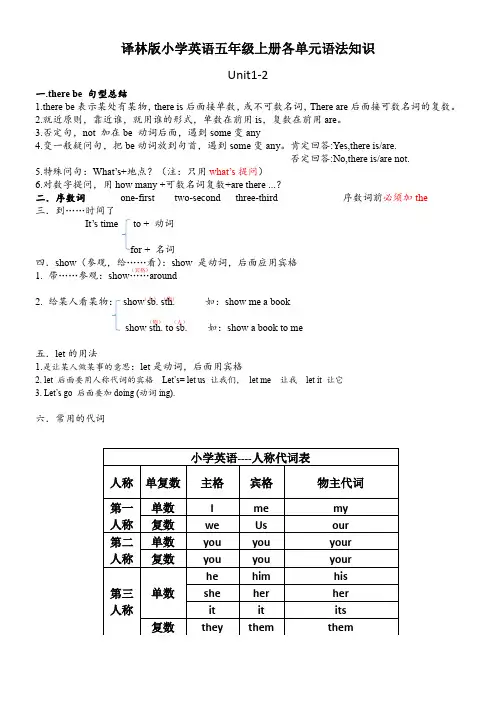
(宾格) (人) (物) (物) (人) 译林版小学英语五年级上册各单元语法知识Unit1-2一.there be 句型总结1.there be 表示某处有某物,there is 后面接单数,或不可数名词,There are 后面接可数名词的复数。
2.就近原则,靠近谁,就用谁的形式,单数在前用is ,复数在前用are 。
3.否定句,not 加在be 动词后面,遇到some 变any4.变一般疑问句,把be 动词放到句首,遇到some 变any 。
肯定回答:Yes,there is/are.否定回答:No,there is/are not.5.特殊问句:What’s+地点?(注:只用what’s 提问)6.对数字提问,用how many +可数名词复数+are there ...?二.序数词 one -first two -second three -third 序数词前必须加the三.到……时间了It’s time to + 动词for + 名词四.show (参观,给……看):show 是动词,后面应用宾格1. 带……参观:show ……around2. 给某人看某物: show sb. sth. 如:show me a bookshow sth. to sb. 如:show a book to me五.let 的用法1.是让某人做某事的意思:let 是动词,后面用宾格2. let 后面要用人称代词的宾格 Let’s= let us 让我们, let me 让我 let it 让它3. Let’s go 后面要加doing (动词ing).六.常用的代词Unit3-4一.have ,has 的用法1.当主语是第三人称单数时,用has,包括he ,she,it.人的名字,单个的人或物体2.当主语是第一、二人称(I/you/we/they,)以及复数时,用have3.否定句:在动词have前加don’t 主语+ don’t + have +.........+ 动词用原形(have)has前加doesn’t 主语+ doesn’t + have+ ........3.一般疑问句,在句首加Do+ 主语+ have(动词原形)……?Does❖如句子中有和“我有关的”第一人称人称需改成和“你”有关的第二人称人称。
语法及练习1 be动词Be 动词的用法:(1) Am--was Is --was Are--were 口诀:我用am, 你用are, is用在他她它,复数全用are。
(2) 肯定和否定句I am (not) from London. He is(not) a teacher. She is(not) in the dining room. My hair is(not) long. Her eyes are(not) small.(3) 一般疑问句Am I a Chinese? Yes, you are. No, you aren’t. Are they American? Yes, they are. No, they aren’t. Is the cat fat? Yes, it is. No, it isn’t.用恰当的be动词填空。
1. I ______ a boy. ______ you a boy? No, I _____ not.2. The girl______ Jack's sister.3. The dog _______ tall and fat.4. The man with big eyes _______ a teacher.5. ______ your brother in the classroom?6. Where _____ your mother? She ______ at home.7. How _______ your father?8. Mike and Liu Tao ______ at school.9. Whose dress ______ this?10. Whose socks ______ they?11. That ______ my red skirt.12. Who ______ I?13.The jeans ______ on the desk.14. Here ______ a scarf for you.15. Here ______ some sweaters for you.16. The black gloves ______ for Su Yang.17. This pair of gloves ______ for Yang Ling.18. The two cups of milk _____ for me.19. Some tea ______ in the glass.20. Gao shan's shirt _______ over there.21. My sister's name ______Nancy.22. This ______ not Wang Fang's pencil.23. ______ David and Helen from England?24. There ______ a girl in the room.25. There ______ some apples on the tree.26. _______ there any kites in the classroom?27. _______ there any apple juice in the bottle?28. There _______ some bread on the plate.29. There _______ a boy, two girls, three men and ten women in the park.语法及练习2 人称代词和物主代词人称代词和物主代词1.人称代词主格和宾格的区别:主格通常位于句中第一个动词之前(有时候位于than 之后),宾格一般位于动词或介词之后。
译林版五年级英语上册语法要点梳理主语与谓语的一致性1. 主语为单数的句子,谓语动词要使用单数形式。
2. 主语为复数的句子,谓语动词要使用复数形式。
3. 主语为第三人称单数(he, she, it)的句子,在一般现在时态下,谓语动词要加-s或-es。
系动词与表语的一致性1. 系动词(be动词)后面的表语要与主语保持一致。
数词的用法1. 用于表示数量的数词,一般在名词前面作定语,例如three books(三本书)。
2. 数词在大于10的数词前通常使用连字符,例如twenty-one (二十一)。
3. 序数词表示顺序,常放在名词前面,例如the first day(第一天)。
形容词的比较级与最高级1. 表示比较级的形容词在句子中比较两个人或物的程度,通常在形容词后面加-er,例如taller(更高的)。
2. 表示最高级的形容词在句子中比较三个或三个以上的人或物的程度,通常在形容词后面加-est,例如the tallest(最高的)。
一般现在时的用法1. 表示经常性动作、惯或客观事实。
2. 一般现在时的肯定句结构:主语 + 谓语动词(原形)。
3. 一般现在时的否定句结构:主语 + do(es) not + 谓语动词(原形)。
4. 一般现在时的疑问句结构:Do(Does) + 主语 + 谓语动词(原形)?一般过去时的用法1. 表示过去发生的事情。
2. 一般过去时的肯定句结构:主语 + 谓语动词(过去式)。
3. 一般过去时的否定句结构:主语 + did not + 谓语动词(原形)。
4. 一般过去时的疑问句结构:Did + 主语+ 谓语动词(原形)?动词的时态1. 现在进行时:主语 + am/is/are + 现在分词(-ing)。
2. 过去进行时:主语 + was/were + 现在分词(-ing)。
3. 将来进行时:主语 + will be + 现在分词(-ing)。
实义动词与情态动词1. 实义动词表示动作或状态的实际发生。
精心整理四年级英语语法一、词类:1、名词精心整理.精心整理一般动词前用主格,动词后用宾格。
有主格和宾格之分。
人称代词:、指示代词3 精心整理.精心整理、冠词4、、itha的区别a用于元音音素(一般就是元音字an有用于辅音音素前。
)前二、否定句+no、b动词aiarcan+ no情态动词+ not )助动词(do、does 如何将一个肯定的陈述句改为否定句:动词后+ not。
动词,如有,直接在1、看句中有无bebe 。
+ not2、看句中有无情态动词,如有,直接在情态动词后、如上述二者都没有,就应用助动词3+ not。
分四个步骤:)肯定陈述句中本来是没有助动词的,要加上去,位置在主语(某人或某物)后,1(动词前。
精心整理.精心整理(2)确定助动词用do、does,根据句中动词,动词是原形的助动词就用do,动词是第三人称单数的助动词就用does,(3)在助动词后加not。
(4)原句中动词假如发生变化就要恢复成原形。
an强调一点,som的要考虑是否要三、一般疑问句如何将一个肯定的陈述句改为一般疑问句动词提到句首即可b动词,如有,be、看句中有、看句中有无情态动词,如有,把情态动词提到句首即可。
2 、如上述二者都没有,就应把助动提到句首。
分四个步骤:3)肯定陈述句中本来是没有助动词的,要加上去,位置在主语(某人或某物)后,(1 动词前。
,动do还是does,根据句中动词,动词是原形的助动词就用do(2)确定助动词用does 词是第三人称单数的助动词就用3)把助动词后提到句首。
()原句中动词假如发生变化就要恢复成原形。
(4 。
的要考虑是否要用强调一点,有someany 精心整理.精心整理四、特殊疑问句。
表示疑问,有疑问词(在开头),回答有很多种可能。
常用疑问词:五、时态1、一般现在时(1)一般现在时中的be动词:精心整理.精心整理一般用原形:am is aream用于第一人称单数(I);is用于第三人称单数(he she it和其他人名或称谓,如:Ben his sister等);are用于第二人称单数(you)和所有复数(包括第一人称复数we、第二人称复数you;第三人称复数they和其他复数,如the children 、his parents等)。
译林版五年级英语上册语法知识总结
本文档旨在总结译林版五年级英语上册的语法知识,帮助学生
巩固所学的知识。
一、词法知识
1. 名词:表示人、事物、地点、动物等具体或抽象事物。
2. 动词:表示动作或状态。
3. 形容词:描述名词的特征或性质。
4. 副词:修饰动词、形容词或其他副词,表示程度、方式、时
间等。
5. 介词:用来引导名词或代词与其他词语之间的关系。
6. 代词:替代名词的词语,如人称代词、物主代词、指示代词等。
二、句法知识
1. 句子的组成:主语 + 谓语 + 宾语 / 宾语补足语 / 定语 / 状语。
2. 句子的分类:陈述句、疑问句、祈使句、感叹句等。
3. 句子的时态:一般现在时、一般过去时、将来时等。
4. 句子的语序:英语中的语序为主谓宾语,但也有例外情况。
5. 句子的标点符号:句号、问号、感叹号等。
三、语法知识
1. 一般现在时:表示经常性、惯性或普遍性的动作或状态。
2. 一般过去时:表示过去发生或存在的动作或状态。
3. 将来时:表示将来发生或存在的动作或状态。
4. 名词单复数:可通过加-s、-es等形式来表示复数。
5. 形容词的比较级和最高级:一般形容词加-er和-est表示比较级和最高级。
6. 物主代词:用来表示所属关系,如my、your、his等。
7. 介词短语:用来表示时间、地点、原因、目的、方式等。
以上是译林版五年级英语上册的语法知识总结,希望能对学生的学习有所帮助。
更多详细内容请参考教材或教师的指导。
译林版英语四年级上册各单元语法归纳与整理本文档对译林版英语四年级上册的各单元语法进行了归纳和整理,旨在帮助学生更好地掌握和运用英语语法知识。
Unit 1- Present tense: 此单元主要研究了英语的一般现在时,用于描述现在正在进行的动作或状态。
例如:- I read books every day.(我每天都读书。
)- She plays soccer on the weekend.(她周末踢足球。
)Unit 2- Past tense: 在本单元中,学生研究了英语的一般过去时,用于描述过去已经发生的动作或状态。
例如:- I watched a movie last night.(昨晚我看了一部电影。
)- They went to the park yesterday.(他们昨天去了公园。
)Unit 3- Interrogative sentences: 本单元重点研究了英语的疑问句,用于提问。
例如:- Do you like ice cream?(你喜欢冰淇淋吗?)- Is she your sister?(她是你的姐姐吗?)Unit 4- Imperative sentences: 此单元主要研究了英语的祈使句,用于表示命令、请求或建议。
例如:- Please clean your room.(请把你的房间打扫干净。
)Unit 5- Possessive pronouns: 本单元研究了英语的所有格代词,用于表示所属关系。
例如:- This is my book.(这是我的书。
)- Is that your pen?(那是你的钢笔吗?)Unit 6- Plural nouns: 本单元研究了英语的复数名词形式,用于表示多个物体或人。
例如:- I have two cats.(我有两只猫。
)- They are my friends.(他们是我的朋友。
)以上是译林版英语四年级上册各单元的语法归纳和整理,希望对学生们的学习有所帮助。